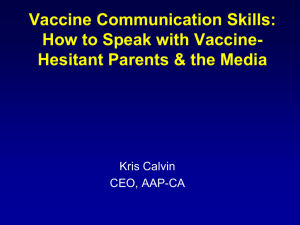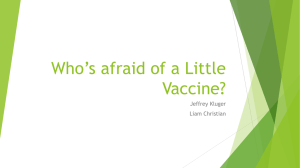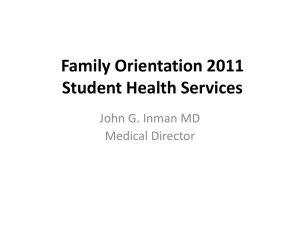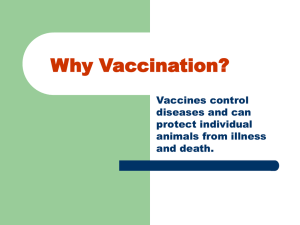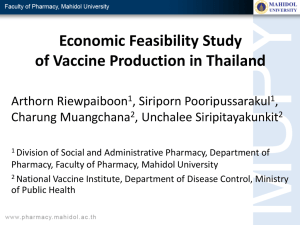E.ictaluri
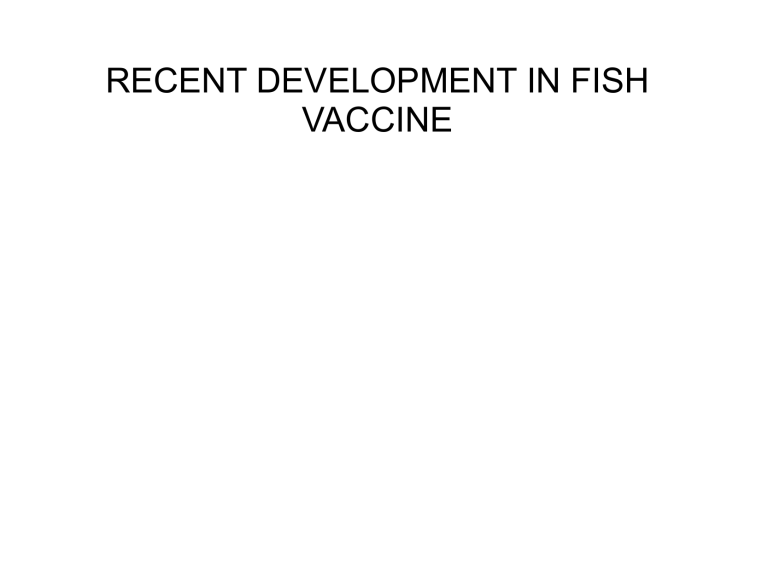
RECENT DEVELOPMENT IN FISH
VACCINE
Introduction
• The first vaccines against Fish infectious bacterial diseases were developed in 1970.
• It is commercial in 1980.
• This has contributed significantly to the growth of the industry to consumer acceptance of farm raised.
• Research over many year very few Anti-viral vaccines are available.
• There are no commercial vaccines against parasite.
Cont…
• Vaccination is becoming an increasingly important part of aquaculture ,since it is considered a cost effective method of controlling different threatening disease.
• Before attempting any vaccination strategy, it is important to determine when the system is both morphologically and functiontionally mature.
• Immunization of pre-spawing females may have potential as a means of protecting fish againist pathogens which affect the early life stages , such as
Flavabacterium psychrophilum, Edwardisiella ictaluri.
Primary Factors Affecting the
Efficacy Of Vaccination
• Types of vaccine formulation
• A) Bacterins:-
Most bacterial vaccines used in aquaculture to date have been inactivated vaccines obtained from broth culture of a specific strain(s) subjected to subsequent formalin inactivation.
Cont…
• The best results are obtained with those bacterins that include both bacterins cells and extracellular products.
• Whereas with some vaccines accepatable levels of protection are achieved with aqueous formulation administered by injection or immersion.
• Bacterins such as those devised for Salmonids against
Aeromonas salmonicidia an accepatable level of protection can only be achieved by immuunization with oil –adjuvanted bacterins delivered by injection.
(B)Live attenuated vaccines
• These should have many advantages in Aquaculture.
• Live vaccines also have the advantage that stimulate the cellular branch of the immune system.
• Some live vaccines have been tested experimentally are
Aermonas salmonicida, Edwardiella tarda E.ictaluri.
Cont…
• At present ,only on E.ictaluri
attenuated live vaccine has licensed in then USA to be used by both in 9-days old fish to prevent ESC of cat fish.
(C)DNA vaccines
DNA vaccines have theoretical advantage over conventional vaccines in mammals the specific immune response after DNA vaccination encompasses antibodies
,T-helper cells and cytotoxic cells.
Cont…
• As the DNA sequence encodes only a single microbial gene , there should be no possibility of reversion to virulence.
• It is a critical factor to factor in enviromental saftey in
Aquaculture.
Current status development of vaccination strategies
Vibriosis
• within the genus Vibrio, the species causing the most economically serious diseases in marine culture are
Vibrio anguillarum , V.ordalii,V.salmonicida and
V.vulnificus.
• Vibrio anguillarum it affect the salmonids and non salmonids with a world wide distribution.
• Although there a great number of commercial Vibrio anguillarum vaccines have been developed for use mainly by injection or both.
Winter ulcer:-
• Winter Ulcer is a disease affecting sea-farmed atlantic salmon.
• It occurs in Norway, Iceland and
Scotland mainly during the winter season.
• An inactivated Oil- aduvanted vaccine against M.viscosa has been shown to give protection in atlantic salmon.
• Today M.viscosa
has been incorporated in the Oil-based mutivalent vaccines employed routienly in the salmon industry of the affected countries.
Pasteurellosis
• Pasteurellosis currently described also as photobacteriods, is caused by the halophilic bacterium
Photobacterium demselae
• Which causes ecnomic losses in the marine culture of yellotail( Seriol a quinquerdiata ) in Japan.
• Sea bream( sparus aureta ) sea bass and sole in the Mediterranean countries of Europe and
• This mortalities occur usually when water temperature are above 18-20 o c.
• In recent year, several commercial vaccines against
P.damselae have been made available on the market but their efficacy is dependent on fish species,fish size,vaccine formulation.
Cont…
• Recently different stable attenuated siderophore deficient and aro-A mutant strains have been constructed using an allelic replacement technique which in experiment trails proved to be useful candidates as live vaccines for striped bass hybrids
• Furunculosis:o Aeromonas salmlonicide is the causative agent so called typical furunculosis which causes economically devastating losses in cultivated salmonids in fresh water and marine waters.
o Although many furunculosis bacterians have been developed and commercialized since 1980 to be used in salmonids by injection, immersion or the oral route.
• Different approaches have been used to develop live attenuated vaccine against furunculosis.
• In recent recombinant DNA technology allowed the construction of highly attenuated and stable aro-A auxotrophic mutant strains using an allelic replacement technique which were employed experimentally as safe live vaccines with a high level of success but their approval for use in the field has not yet been forthcoming.
• Yersiniosis:o Yersinia ruckeri is the causal agent of yersiniosis or enteric redmouth (ERM) disease.
o Although commercial ERM vaccines have been extensively used for decades with generally high efficacy they do not eliminate the carrier state, since the apparently healthy vaccinated fish act as a vehicle by which ERM could be spread into non-endemic areas of the disease. o Therefore, the inclusion of atleast the predominated serovaes in the commercial
• Enteric septicaemia of cat fish,
ESC ( Edwardsiella citaluri )
Edwardsiella citaluri is the enterobacterium responsible for enteric septicemia of catfish, with channel cat fish being the most susceptible fish species among the
E. citaluri .
o E.ictaluri
is an intracellular pathogen for channel catfish it is not unusual that killed vaccines have not been very successful.
• Recently an attenuated O-antigen deficient E.ictaluri
strain has been developed which was safe and provided high long lasting acquired immunity following a single both immersion in 9-14 day old channel catfish without booster vaccination.
• This modified live E.citaluri
vaccine has been produced since 2000 by invest inc.
• Cold water disease or rainbow trout fry syndrome:-
• Flavobacterium psychrophilum has been known as the causative agent of bacterial cold water disease (BCWD).
• The few vaccination attempts for preventing the disease caused by F. psychrophilum have been published.
• Recent vaccination experiment performed with young rainbow trout demonstrated that only significant protection was achieved using oil-adjuvanted ip(Intraperitoneal) vaccines.
• There is no commercial vaccine against this disease are available, some countries using autogenous bacterins made from single form isolates.
• Pseudomonadiasis:o The Pseudonas species recovered from disease fish.
Pseudomonas anguillisetica is considered the significant pathogens for cultured fish.
o This fish cause red spot disease.
o In recent research efforts production of aqueous and non-mineral oil-adjuvanted bacterians with proved to be effective in experiment trials in gilthead sea bream and turbot.
• Bacterial kidney disease:o BKD caused by the grampositive diplobacillus.
o Renibacterium salmoinarum is a chronic systemic disease of salmonids which causes mortality in cultured fish in fresh and marine environment.
o Recently a commercial aqueous live vaccine developed by Novartis S.A has been licensed under the name of ‘Renogen’ for BKD prevention.
• This vaccine is constituted by live cells of Arthobacter davidanieli , a non-pathogenic environmental bacterium which express an extracellular polysaccharide with antigenic homology to that of R. Salmoninalum .
• Future prospectus:o To achieve progress in fish vaccinology, an increase in the co-operation between basic and applied science is needed.
o Improvement in oral immunity with biodegradable microparticle based vaccines to be used for booster vaccination.
• Development of new non-mineral oil adjuvants lacking side effects.
• Development of poly valent vaccines and stabilization of a vaccine calendar appropriate each economically important fish species.
• Investigation of the mechanisms of immunoglobulin transfer from pre spanning females to offsprings as a useful way of protecting fish against pathogens which affects early life stages.

